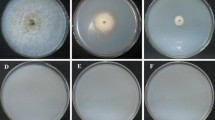Summary
The genomic distribution and genetic behavior of DNA sequences introduced into the tomato genome by Agrobacterium tumefaciens were investigated in the backcross progeny of 10 transformed Lycopersicon esculentum x L. pennellii hybrids. All transformants were found to represent single locus insertions based on the co-segregation of restriction fragments corresponding to the T-DNA left and right border sequences in the backcross progeny. Isozyme and restriction fragment length polymorphism (RFLP) markers were used to test linkage relationships of the insertion in each backcross family. The T-DNA inserts in 9 of the 10 transformants were mapped in relation to one or more of these markers, and each mapped to a different chromosomal location. Because only one insertion did not show linkage with the markers employed, it must be located somewhere other than the genomic regions covered by the markers assayed. We conclude that Agrobacterium-mediated insertion in the Lycopersicon genome appears to be random at the chromosomal level. No discrepancies were found between the T-DNA genotype and the nopaline phenotype in the 322 backcross progeny of the nopaline positive transformants. Backcross progeny of two nopaline negative transformants showed incomplete correspondence between the T-DNA genotype and the kanamycin resistance phenotype. No alteration of T-DNA was observed in progeny showing a discrepancy between T-DNA and kanamycin resistance. However, two kanamycin resistant progeny plants of one of these two transformants possessed altered T-DNA restriction patterns, indicating genetic instability of the T-DNA in this transformant.
Similar content being viewed by others
References
Bernatzky R, Tanksley SD (1985) Genetics of actin-related sequences in tomato. Theor Appl Genet (in press)
Bernatzky R, Tanksley SD (1986) Towards a saturated linkage map in tomato based on isozymes and random cDNA sequences. Genetics (in press)
Bevan M (1983) Binary Agrobacterium vectors for plant transformation. Nucl Acids Res 12:8711–8721
Deblaere R, Bytebier B, De greve H, Deboeck F, Schell J, Van Montagu M Leemans J (1985) Efficient octopine Ti plasmidderived vectors for Agrobacterium-mediated gene transfer to plants. Nucl Acids Res 13:4777–4788
de Block M, Herrera-Estrella L, Van Montagu M, Schell J, Zambryski P (1984) Expression of foreign genes in regenerated plants and in their progeny. EMBO J 3:1681–1689
Dansmuir PS, Smith S, Bedbrook JA (1983) A number of different genes for the small subunit of ribulose bisphosphate carboxylase are transcribed in Petunia. Nucl Acids Res 11:4177–4183
Fraley RT, Rogers SG, Horsch RB, Sanders PR, Flick JS, Adams SP, Bittner ML, Brand LA, Fink CL, Fry JS, Galluppi GR, Goldbery SB, Hoffmann NL, Woo SC (1983) Expression of bacterial genes in plant cells. Proc Natl Acad Sci USA 80:4803–4807
Gamborg OL, Miller RA, Ojima K (1968) Nutrient requirements of suspension cultures of soybean root cells. Exp Cell Res 50:151–158
Herrera-Estrella L, Depicker A, Van Montagu M, Schell J (1983) Expression of chimaeric genes transferred into plant cells using a Ti-plasmid-derived vector. Nature 303:209–213
Hoekema A, Hirsch PR, Hooykaas PJJ, Schilperoort RA (1983) A binary plant vector strategy based on separation of vir-and T-region of the Agrobacterium tumefaciens Ti-plasmid. Nature 303:179–180
Horsch RB, Fraley RT, Rogers SG, Sanders PR, Lloyd A, Hoffmann N (1984) Inheritance of functional foreign genes in plants. Science 223:496–498
Horsch RB, Fry JE, Hoffmann NL, Eichholtz D, Rogers SG, Fraley RT (1985) A simple and general method for transferring genes into plants. Science 227:1229–1231
Jones JDG, Dunsmuir P, Bedbrook J (1985) Higher level expression of introduced genes in regenerated transformed plants. EMBO J 4:2411–2418
Jorgensen RA, Cuellar RE, Thompson WF (1982) Modes and tempos in the evolution of nuclear-encoded ribosomal RNA genes in legumes. Carnegie Inst Wash Year Book 81:98–101
Murashige T, Skoog F (1962) A revised medium for rapid growth and bioassay with tobacco tissue cultures. Physiol Plant 15:473–497
Murray MG, Thompson WF (1980) Rapid isolation of high molecular weight plant DNA. Nucl Acids Res 8:4321–4325
Otten LA, Schilperoort RA (1978) A rapid micro scale method for the detection of lysopine and nopaline dehydrogenase activities. Biochem Biophys Acta 527:497–500
Sengupta-Gopalan C, Reichert NA, Barker RF, Hall TC, Kemp JD (1985) Developmentally regulated expression of the bean beta-phaseolin gene in tobacco seed. Proc Natl Acad Sci USA 82:3320–3324
Shah DM, Hightower RC, Meagher RB (1982) Complete nucleotide sequence of a soybean actin gene. Proc Natl Acad Sci USA 79:1022–1026
Tanksley SD (1984) Linkage relationships and chromosomal locations of enzyme-coding genes in pepper, Capsicum annuum. Chromosoma (Berl) 89:352–360
Tanksley SD, Zamir D, Rick CM (1981) Evidence of extensive overlap of sporophytic and gametophytic gene expression in Lycopersicon esculentum. Science 213:453–455
Thompson WF, Everett M, Polans NO, Jorgensen RA (1982) Phytochrome control of RNA levels in developing pea and mungbean leaves. Planta 158:487–500
Vallejos CE (1983) Enzyme staining activities. In: Tanksley SD, Orton TJ (eds) Isozymes in plant genetics and breeding Elsevier Publ, Amsterdam, p 469–516
Vallejos CE, Tanksley SD, Bernatzky R (1985) Localization in the tomato genome of DNA restriction fragments containing sequences homologous of the rRNA (45s), the major chlorophyll a/b binding polypeptide and the ribulose bisphosphate carboxylase genes. Genetics (in press)
Van der Elzen P, Lee KY, Townsend J, Bedbrook J (1985) Simple binary vectors for DNA transfer to plant cells. Plant Mol Biol (in press)
Zambryski P, Joos H, Genetello C, Leemans J, Van Montagu M, Schell J (1983) Ti plasmid vector for the introduction of DNA into plant cells without alteration of their normal regeneration capacity. EMBO J 2:2143–2150
Zambryski P, Herrera-Estrella L, De Block M, Van Montagu M, Schell J (1984) The use of the Ti plasmid of Agrobacterium to study the transfer and expression of foreign DNA in plant cells: New vectors and methods. In: Setlow J, Hollaender A (eds) Genetic engineering principles and methods, vol 6. Plenum Press, NY, p 253–278
Author information
Authors and Affiliations
Additional information
Communicated by J. Schell
Journal article no. 1223 of the New Mexico Agricultural Experiment Station
Rights and permissions
About this article
Cite this article
Chyi, YS., Jorgensen, R.A., Goldstein, D. et al. Locations and stability of Agrobacterium-mediated T-DNA insertions in the Lycopersicon genome. Molec Gen Genet 204, 64–69 (1986). https://doi.org/10.1007/BF00330188
Received:
Issue Date:
DOI: https://doi.org/10.1007/BF00330188




